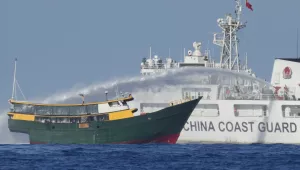Overview
Although the concept of geopolitical resources is rarely used, geopolitical resources themselves are permanently employed. The fate of a nation, or the rise and fall of a country, depends in larger part on the country’s geopolitical resources and the nation’s ability in exploiting those resources.
Vietnam’s Geopolitical Resources in Today’s World Politics
Vietnam’s geopolitical resources consist of numerous ingredients, whose values and significance are subject to change. For example, the country is a gateway to sea for Laos and Cambodia, but how valuable this location is depends on how wealthy the latter are. Geopolitical resources are to be found not merely in geography, as classic geopolitics asserts. Nor do they result from power relationships, as the Kissingerian school understands. They are indeed the compound of relative advantages endowed by geography with a certain international constellation. The international political-economic constellation in which Vietnam finds itself will determine which elements in the country’s geographical endowment are more valuable and more strategic.
Today Vietnam is located in a strategic playing field in which the major players are — according to their ambitions and capabilities — China, the United States, Japan, and India.
In the past, Vietnam’s strategic import to China lay in its role as the latter’s gateway to the south. But in the present, this role is increasingly played by others. China is trying to convert the South China Sea and Myanmar into its main gateways to the south. In the South China Sea, China invaded the Paracel Islands in 1974 and occupied several reefs in the Spratlys since 1988. It maintains military bases on Myanmar’s shores and plans to build a pipeline linking its southwest province Yunnan to Sittwe, Myanmar’s deep-water seaport on the Bay of Bengal. Vietnam’s role as a gateway to sea for China’s southwest is being diminished by the increasing traffic between Yunnan and Myanmar, and by the development of Guangxi’s seaports on the Tonkin Gulf. Vietnam’s strategic import to China is further downgraded after the establishment of a “strategic partnership” between China and Indonesia in April 2005. Indonesia is the largest Southeast Asian country in terms of both population and territory, but more importantly, it provides the sea route linking the South China Sea to the Indian Ocean. Thus, with its control of the South China Sea and close ties with Myanmar and Indonesia, China can have secure access to the Indian Ocean and, at the same time, a pair of pincers to tame Southeast Asia.
China’s expansion of its control in the South China Sea and its influence in Southeast Asia occurs in the context of its rise to the status of world power and regional leader. All this has led the United States, Japan, and India to direct attention toward Southeast Asia and the South China Sea, and seek measures to cope with this new development.
With its desire for “world leadership,” the United States regards the rise of China as a threat at the grand strategic level. Although Japan and India have no global ambition, the two do want to become Asia’s regional powers. Naturally, they would not tolerate China’s ascent to regional leadership. Japan has opted for a strategic alliance with the United States, thus taking shelter under America’s global hegemony in order to oppose China’s regional leadership. India has sought a “freer” position, but basically it is also a strategic alignment with the United States. A conflict over regional leadership has emerged in Asia between China on one side and the United States, Japan, and India on the other.
This constellation has made Southeast Asia and the South China Sea a strategic theater in the playing field of great power rivalry. The South China Sea is of vital interest for both China and Japan. 90 per cent of oil supplies for Japan, 80 per cent of oil supplies for China, and most of the goods exchanged between the two countries and the Middle East and Europe flow through the Sea. Although the South China Sea is not that important to the United States, Washington has strategic interests in it. Control of the Sea means control of the major sea lane of communication between the Indian and Pacific Oceans and a lifeline of East Asian economy.
Occupying a half of the islands in the Spratlys and having a long coastline closest to the center of the main maritime route through the South China Sea, Vietnam is the geographically most advantageous place from which to control the South China Sea. Among all the Southeast Asian states, it has the longest history and the richest experience of dealing with China. These are the reasons why Japan, the United States, and India all want to see Vietnam play an active role in the South China Sea’s security and align with them in case of tension in great power relations.
The rise of China has increased the strategic import of Southeast Asia, the South China Sea, and Vietnam in the global chessboard. Vietnam has become one of the countries most important strategically for Japan. Its significance to America has changed from a chapter in history to an actor in strategy. Given its rivalry with China in the South China Sea, Vietnam cannot become Beijing’s strategic ally in the region. On the contrary, Hanoi presents the biggest hurdle that stands in the way of China’s southward movement.
This southward movement is part of China’s “peaceful rise” grand strategy. According to an article on “peaceful rise and China’s South Sea policy,” which appeared in the journal of the Guangdong Industrial University in March 2005, China’s rise can be divided into three stages. The first is called the “nurture” stage, in which China will take a defensive posture and give priority to territorial integrity. The second stage is the “establishment” phase. In this stage, China will take a proactive posture and its objective is the “retrieval of the lost territories.” The last stage is called the “governance” period. China will try to let the international community accept a political-economic order favorable to China, and its objective in this stage is to reach a strategic equilibrium and stability.
This strategy implies that right now China still must “hide its capacities and bide its time” (taoquang yanghu), as the late Deng Xiaoping advised in 1991. But in the second stage, China will try to expand its control over Taiwan and the South China Sea. Ultimately, its long-term goal in the third stage is to assume regional and world leadership.
While China is aspiring for regional and global preponderance, other great powers also pursue their own grand strategies, which can be divided into three stages similar to China’s. However, given their capabilities, the United States is already in the third stage, and Japan is beginning the second stage, in their own paths of rise. Thus in Washington’s view, it is its responsibility to take control of world order and intervene in where is the source of instability. Japan is extending both the perimeter of its defense and the area of its vital interests. Only India is still at the beginning of its first stage. All these are creating a complex contest among the great powers, each at a different stage in its own path of rise. To navigate this whirlpool, Vietnam must be very clear- and far-sighted and resolute.
Vietnam’s Geopolitical Resources in Globalization
Whereas divergence is threatening East Asian politics, convergence is the trend of its economy. Market forces are highly active in the region, creating a huge need for transportation and trade between different places. Against this background, Vietnam’s location at the lifeline of the region’s economy and particularly Southern and Central Vietnam’s location at the pivot of Southeast Asia are the country’s invaluable resources. There are two general ways to exploit these geopolitical resources. Vietnam can try to become either a “gateway” from the Asian landmass to the Pacific Ocean or a “bridgehead” on the shores for the trading routes, both maritime and airborne, across the South China Sea.
Each of the Vietnamese regions can, however, assume a different role. Northern Vietnam can act as a sea gateway for China’s southwest, Central Vietnam for Northeast Thailand and Laos, and Southern Vietnam for Cambodia. Yet the gateway can only be busy when its hinterland produces much. Given the present capacity of Vietnam’s hinterland, the “gateway” role cannot be a key to Vietnam’s growth strategy. The country is left with no alternative than to “pull” the trading route via the South China Sea into its seaboard.
A look at the map suggests that Vietnam can try to become an entrepot on this sea route or to act as the hub of southeastern Asia. But these strategies are extremely difficult to achieve. Vietnam can become the hub of southeastern Asia only when it has established itself as both the gateway and the entrepot. Not only the gateway role but also the entrepot role is unrealistic for Vietnam. Modern technology has guaranteed that the region is not in need of a third entrepot comparable to Hong Kong and Singapore.
The only feasible approach for Vietnam to bring into play its geopolitical resources and become a critical nexus in the trans-East Asian trading network is to closely link itself with other critical nexuses in the transregional lifeline, which run through the South China Sea, and, using the spin-over effect, to create an additional nexus on Vietnam’s soil. Recently, Vietnam has made some initial steps in linking its economy with those of Japan and Singapore. These are steps in the right way because the complementarity between Vietnam and Singapore as well as between Vietnam and Japan is nearly ideal. Following this path, Vietnam should become Singapore’s hinterland, providing the world trade and financial center with land and people. At the same time, it should attract a large amount of Japanese capital, technology and know-how to create on its soil a new critical nexus of the trans-East Asian trading network.
In the course of its development, Vietnam will be confronted with the imbalance of geopolitical resources between its regions, which may lead to their unequal development. Geopolitical resources are not only a matter of place and man but also a matter of time. Vietnam’s present territory used to be a critical nexus in the trans-East Asian trading networks of the past. However, as transportation and communication technology progressed, the site of the nexus was shifted: from two separate nexuses in the North (Giao Chi) and the South (Funan), converging into one in the Middle (Champa), then moving to the South (Dong Nai-Ben Nghe). Giao Chi and Funan reached their climax in the first half of the first millennium A.D. Champa rose in the first half, but felt in the second half, of the second millennium. The role of Champa was taken over by the Dong Nai-Ben Nghe region. But the latter soon had to struggle against the effect of technology, which permitted ships to travel longer distances than previously, thus reducing the number of ports they had to visit during a voyage.
In the present day, Northern Vietnam, due to its far location and its being blocked by Hainan Island, cannot be a nexus in the main maritime route of the South China Sea. Central Vietnam has the closest coastline to the route and numerous deep-water and wind-tight port locations. Yet its topography divides it into several small valleys, making land transportation difficult. The Southeast, which is home to Ho Chi Minh City, is much more favorably endowed with space for expansion, hinterland, and purchasing power. It is already the economic hub of a subregion that comprises Southern Vietnam, Central Vietnam, and Cambodia. Thus, Central Vietnam’s comparative advantages can be fully exploited only if it adopts an extremely outward-oriented outlook and embeds itself in the international trading networks. This requires that investment in Central Vietnam be aimed to serve primarily the international market, not necessarily the domestic market.
Geopolitical resources are crucial to the fate of a country. The rise and fall of a nation depends to a large extent on the human ability to fully employ its geopolitical resources. We nowadays are witnessing the emergence of a new world order, in which Vietnam lies at both a main cleavage of great power rivalry and a major linkage of regional economic integration. This poses great challenges, but at the same time, offers golden opportunities for the country.
Note: The author is a research fellow at the Belfer Center for Science and International Affairs, Kennedy School of Government, Harvard University.
Vuving, Alexander. “Vietnam's Geopolitical Resources.” The Saigon Times Weekly, October 15, 2005
The full text of this publication is available via The Saigon Times Weekly.





